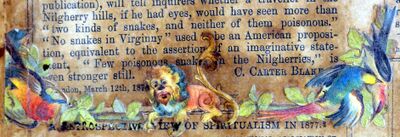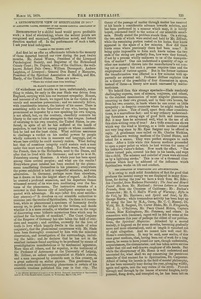< Isis Unvelled and the Todas (continued from page 7-13) >
and the current authorities being on one side, and “H. M.” on the other, anthropologists may be able to draw their own conclusions as to the accuracy of statements which appear to be corroborated by those persons who are qualified to give evidence to scientific men as to points of Indian anthropology.
On a more particularly zoological subject I may note that Dr. Joseph Fayrer’s work, The Thanatophidia of India; being a Description of the Venomous Snakes of the Indian Peninsula, folio, Lond., 1872; and Dr. Albrecht Gurther’s Reptiles of British India, 8vo, Lond., 1864 (Ray Society’s publication), will tell inquirers whether a traveller in the Nilgherry hills, if he had eyes, would have seen more than “two kinds of snakes, and neither of them poisonous.” “No snakes in Virginny” used to be an American proposition, equivalent to the assertion of an imaginative statement. “Few poisonous snakes in the Nilgherries,” is even stronger still.
London, March 12th, 1878.

A Retrospective View of Spiritualism in 1877*
Retrospection by a skilful hand would prove profitable work; a kind of stocktaking, where the salient points are recognised and examined, imperfections noted, and future direction marked off. In the performance of such a task, I ask your kind indulgence.
And first let us offer an affectionate tribute to the memory of those departed beyond our view during the past twelve months. Mr. James Wason, President of the Liverpool Psychological Society, and Registrar of the Birkenhead County Court; Dr. Dupuis, editor of the Gallileen; the well-known Robert Dale Owen; William Davenport; Andrew Leighton, of Liverpool; General Don Bassol y Maranoso, President of the Spiritual Association at Madrid, and Mrs. Hardy, of the United States. These are now—
Of wickedness and trouble we have, unfortunately, something to relate, for early in the year Slade was driven from England, carrying with him our warmest sympathy. Honest, and innocent of all deceit, we regard him as the victim of an unruly and senseless persecution; and we naturally follow, with considerable interest, the history of his career. There is something noble in the behaviour of one who, having been pronounced an impostor by a race speaking his own tongue, is not afraid, but, on the contrary, cheerfully commits his liberty to the care of utter strangers to that tongue. Instead of returning to his own country, the United States, he preferred, in spite of all he has suffered at the hands of prejudice, to cast his lot among people on whose consideration he had not the least claim. What sublime assurance to challenge a verdict on his medial powers by people wholly unknown to him in manners and language, and on whose bare civility he could scarcely reckon. What feeling but that of conscious integrity could sustain such a man under this most novel ordeal. Yet Slade went, first among the French, then to the Hollanders, next to the Danes, and after that he lived with the Germans; and now he is at St. Petersburg among Russians. A whole year has been spent among these several peoples; and what are the results? Everywhere great interest has been excited by the phenomena manifesting themselves in his presence; everywhere the power exhibited is held in respectful attention, and even admiration. In Germany, perhaps more than elsewhere, has it drawn on him the largest share of regard. At Berlin he created a profound sensation, and his departure thence witnessed several of its wise men meditating over the features of the phenomena. The instructive remarks of a reviewer in that famous city of intelligent sceptics may be quoted with advantage. He says (after five most satisfactory seances)— “It devolves on our scientific authorities to examine into the truths of Spiritualism. On them is it incumbent, while so phenomenal a specimen of humanity dwells among us, to probe the subject to the bottom, and decide whether it is a mere swindle, or whether we are on the verge of discovering some hitherto mysterious force which may be utilised for the benefit of mankind.” The Court Conjurer of the Emperor of Germany has also taken the field of criticism and enquiry; and certifies, avowedly for the love of truth (a love which happily dwells in the minds of someconjurers), that the phenomenal occurrences with Mr. Slade have been thoroughly examined by him with the minutest observation, and investigation of the surroundings, including the table; and he declares that he has not in the smallest instance found anything to be produced by means of prestidigitative manifestations or by mechanical apparatus, More than all others, and far superior, is the testimony of the Professor of Astronomy at the University of Leipzig, Mr. Zollner, an ardent experimentalist at Slade’s seances, and a man recognised by scientific men in this country, as a great authority on stellar physics. This gentleman has recorded some most interesting phenomena in certain of his scientific treatises published this year in that city. The theory of the passage of matter through matter has received at his hands a considerable advance towards solution, and has been performed in a manner which may, it is boldly hoped, commend itself to the notice of our scientific assailants. Briefly stated the problem stands thus. On a string, the two ends of which were sealed and held by Mr. Zollner, while the remaining portion rested on his knees, four knots appeared in the space of a few minutes. How did these knots come where previously there had been none? It being quite impossible to form such knots unless the two ends of the string are perfectly free, how were they formed, if not by a process wholly unknown to us of the manipulation of matter? One can understand a quantity of rags or other raw material thrown into the manufacturer’s vat coming out as paper; but such a process requires time and the employment of various agents. But in the former instance the transformation was effected in a few minutes with apparently no external aid. Professor Zollner explains this on a theory of the possibility of four dimensions in space, instead of three—a theory now much canvassed by mathematicians.
We behold then this strange spectacle—Slade resolutely challenging experts, men of science, conjurers, and others, to the strictest examination of most singular phenomena, occurring on their own ground, and in their own houses, far from his own country, in lands where he can count on little sympathy; in despotic countries where he might readily be cast into prison. This of itself, apart from other considerations, is a marvellous fact: and to any ordinary understanding furnishes a strong sign of good faith and innocence. But it may here be advanced well, what is the use of all this slate-writing even if true? Asa trifle sometimes shows which way the wind is blowing, so a little incident related not very long since by Mr. Epes Sargent may be offered in reply. A gentleman once called on Mr. Charles Watkins, the well-known writing medium of the United States, and asked for a stance. They were perfect strangers to each other. After a little while this famous medium proceeded to open a paper pellet on which he had written the name of his unknown visitor’s father. Now mark the effect. “The visitor turned pale, covered his face in his hands, and wept like a child. The atheism and unbelief of years were shivered as by a lightning stroke.” This is one of a thousand illustrations which may be adduced of the influence which Spiritualism works on life and conduct.
It is owing to such solid foundation of fact for good that produces the mental energy we see displayed in many directions, for during the year we have a work from Mr. Riko; Isis Unveiled, from Madame Blavatsky; The Soul and Howit Found Me, from Mr. Maitland; Serious Letters to Serious Friends, from the Countess of Caithness; Mr. Barkas’s Researches; Mr. S. C. Hall’s Words of Warning; Rifts in the Veil, by Mr. Harrison; and Spirit and Soul, by Mr. George Harris; while tremendous activity has been kept up all along the line by M.A., Oxon, Mr. C. C. Massey, Dr. Wyld, Mr. E. Sargent, Dr. Carter Blake, Mr. D. Fitzgerald, Mr. J. L. O’Sullivan, Mr. Peary Chand Mittra, Captain James, Miss Kislingbury, Mr. Peterson, and others. In connection with literature, regret will be felt by some at the disappearance this year of perhaps the oldest of our publications, the Spiritual Magazine. Attacked by a mortal malady, it lingered on for some months, becoming gradually more and more etherealised, until at length it vanished out of sight altogether. And we cannot here well omit Mr. Home’s contribution. It may be said, sans malice, of this <... continues on page 7-14 >
* An address delivered at a soiree of the British National Association of Spiritualists, held at 38, Great Russell-street, London, on Wednesday, March 13th, 1878.

Editor's notes
Sources
-
London Spiritualist, No. 290, March 15, 1878, pp. 123-6


